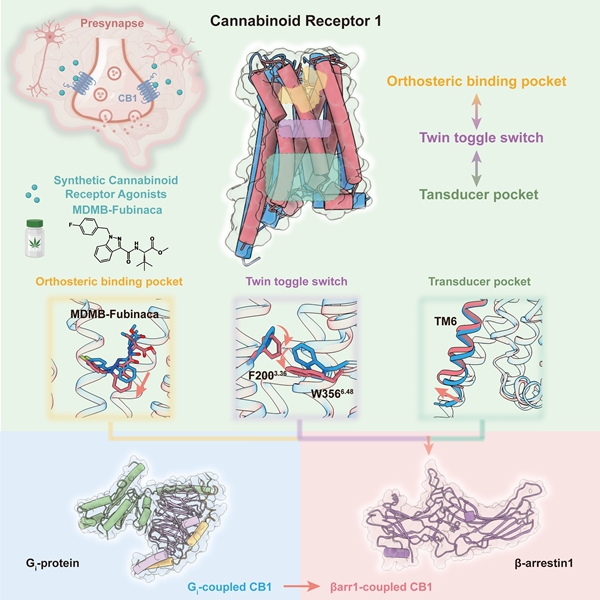Addressing the long-standing Cannabis problem, an oddity that has vexed scientists for decades, joint research by Professor LI Xiao-Ming and Professor ZHANG Yan from Zhejiang University School of Medicine achieved a breakthrough by unraveling signaling bias mechanism toward cannabinoid receptor 1 (CB1), facilitating safer synthetic cannabinoid targeting CB1. The findings were published in Cell under the title “Snapshot of the cannabinoid receptor 1–arrestin complex unravels the biased signaling mechanism” on Dec 14th, 2023.

Over the last ten years, the research team led by Prof. LI Xiao-Ming has been dedicated to identifying key target molecules CB1 in nervous system diseases and developing corresponding treatment strategies, thereby rendering CB1 a promising therapeutic target for pain relief, anti-anxiety, and anti-depression treatment.
Cannabis activates CB1, which elicits analgesic and emotion regulation benefits, along with adverse effects, via Gi and β-arrestin signaling pathways. However, the lack of understanding of the mechanism of β-arrestin1 (βarr1) coupling and signaling bias has hindered drug development targeting CB1.
Prof. ZHANG Yan and his team have been devoted to studying the signaling transduction mechanisms of GPCR in major diseases and have also made substantial contributions to the advancement and establishment of cryo-electron microscopy (cryo-EM)-based GPCR pharmacology.
Prof. LI Xiao-Ming, Prof. ZHANG Yan and their colleagues have cooperated to determine the 3.1 Å cryo-EM structure of the CB1–βarr1 complex. The availability of high-resolution map facilitates the accurate determination of the binding features of ligand in the CB1–βarr1 structure and reveals notable differences in the transducer pocket and ligand-binding site compared with the Gi-protein complex, a task that has been unachieved in most GPCR–βarr1 complexes characterized at lower resolutions. βarr1 occupies a wider transducer pocket promoting substantial outward movement of the TM6 and distinctive twin toggle switch rearrangements, whereas FUB adopts a different pose inserting more deeply than the Gi-coupled state, suggesting the allosteric correlation between the orthosteric binding pocket and the partner protein site.

Taken together, the joint labs led by Professors Li and Zhang have pioneered studies of cannabinoid receptors. Furthermore, this research not only proposes a comprehensive model for the molecular mechanism of signaling bias, but also builds a solid foundation for the development of safer synthetic cannabinoids and the clinical application for the CB1 compounds in treating neurological and psychiatric disorders.